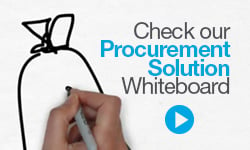Integrated Supplier Management, the Hot Item in Global Procurement

In the Global Procurement Solutions space there are many applications and solutions to help you manage your critical spend. But what about your non-critical spend? The printer cartridges, office supplies, janitorial supplies, MRO items, other IT peripherals etc.
This can often turn into maverick spending; yet it’s not the strategic material critical to operating your business (although I would say poor procurement of this material can cause serious disruptions in office functioning).
Non-critical spend typically comprises about 15-20% of an organization’s procurement spend. If you spend about $300 - $400 million with outside vendors the non-strategic spend makes up about $70 million. That’s not chump change.
Are you handling this with core spend procurement? Are you getting lost in exception management? Are too many vendors wasting precious buyer time? To solve this situation allow me to introduce Integrated Supply Management (ISM), a supply management, cloud-based solution in the global procurement solutions category. 
How exactly does Integrated Supply Management work? Through a third-party service provider that manages your non-critical spend for you while providing expected benefits and more. Here are the four components that comprise ISM and how they benefit your company:
1. Classify tail-end and define rationalization opportunity
The first step is to get a handle on how you’re actually are spending on non-core materiel and services. This might not comprise the bulk of your spending, but it’s usually spread over many suppliers. This is the tail-end spend: lots of vendors supplying you with large quantities of smaller dollar items. These little purchases all add up.
You might categorize all your non-critical spend into company-specific taxonomy classes like office supplies, contract labor, administrative services, or non-critical IT supplies, for example. Once you’ve identified the categories you can now identify how many suppliers you have in each region or location for each category (if you have multiple locations).
Finally, start rationalizing suppliers. If you have 20 office supply vendors you could pare these down to four or five.
2. Supplier Information management
The second step is the supplier registration process using a self-service Supplier Information Management application. This is a collaborative platform where vendors enter their contact details, their product category, and product details such as pricing, sizes, specs, etc.
The supplier enters the information and is also responsible for maintaining and updating the details on an ongoing basis.
The Supplier Information Management application can now be used to procure the non-critical products. The client can browse through suppliers in specific categories, and can search for products by keywords or item number. It’s an almost Amazon.com-like experience, except suppliers are already approved, and payment methods as well as purchase order procedures are established ahead of time.
3. Competitive Bidding for Market pricing
The third step in the ISM process is to define a competitive bidding process. The result of your spend analysis will show you categories where you can set up competitive bidding events with multiple suppliers.
This bidding process is referred to as an E-RFP event. Multiple suppliers are invited to enter their best possible bid, delivery conditions and fulfillment criteria. Then through a simple legal process the winning suppliers sign a contract with the client to freeze pricing for a period of time.
You’re now ready to manage the purchase order process. When a procurement request comes in, the ISM buyer enters the Supplier Information Management application, identifies the right supplier, checks the contracted price, and processes the P.O. in the purchasing system defined.
Following this process ensures that the majority of spend goes to contracted suppliers, a huge benefit that drives productivity, reduces supplier count, and drives important savings for the client.
4. Purchase Order Fulfillment visibility
The final stage in the ISM process is to ensure the P.O. lifecycle is mapping to contracted terms, while you manage any exceptions that might arise.
For example, let’s say you’ve placed a PO for 200 printer cartridges for your office in Monterrey, Mexico for Dec. 1st delivery. The next step is for your supplier to acknowledge the order and confirm the delivery date. But what if the supplier is unable to deliver by Dec. 1st and can only deliver by the 15th?
At this point ISM leverages an application known as a Purchase Order Management system that allows your supplier to either acknowledge their ability to deliver the product on the required date, or to propose an alternate delivery date that the client must respond to inside the app (if they accept the new date).
The P.O. is then amended within the app, and the new delivery date is entered. Through this cloud-based P.O. management application you get visibility into the status of all your P.Os so you can manage your exceptions.
Conclusion
Integrated Supply Management allows outsourcing of management of non-core spend – an often ignored yet critical component of the global procurement process.
Through the use of applications such as Supplier Information Management and Purchase Order Management, and leveraging processes to categorize your spend, collect supplier information, negotiate contracted prices, and executing bidding events, you can reduce your non-critical spend while rationalizing suppliers and simplify your procurement process.



